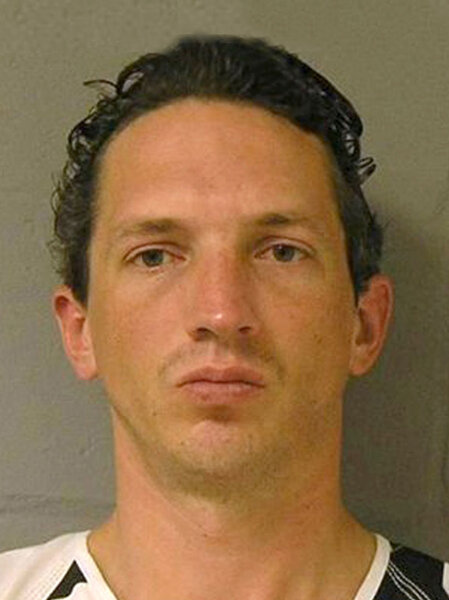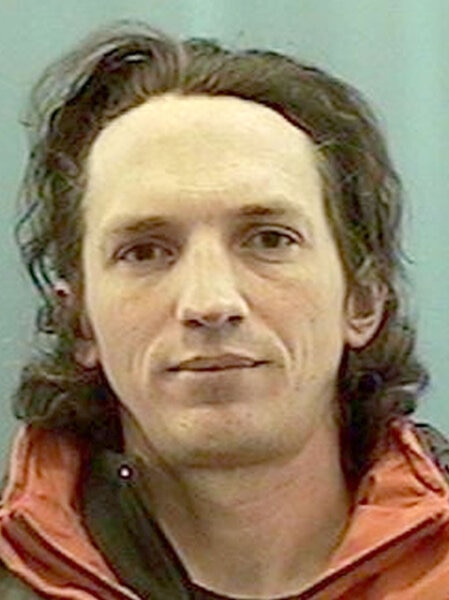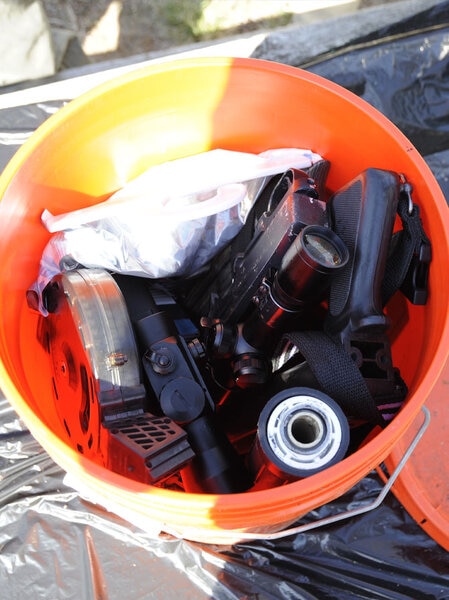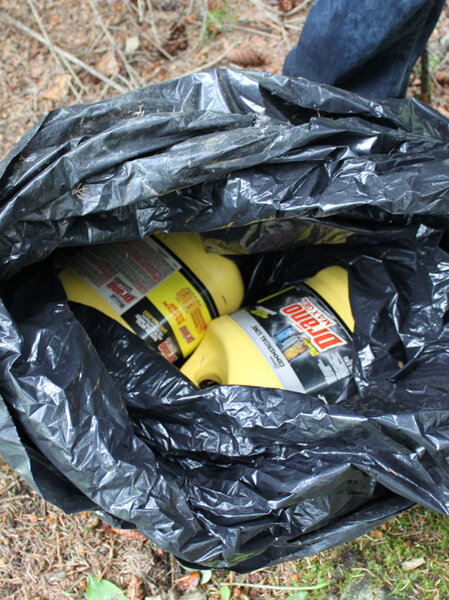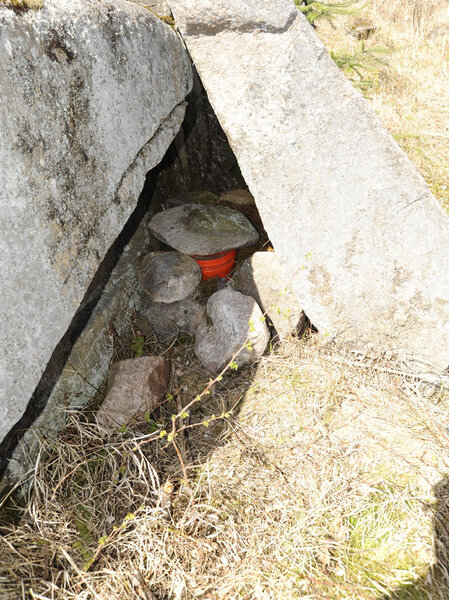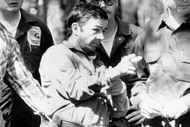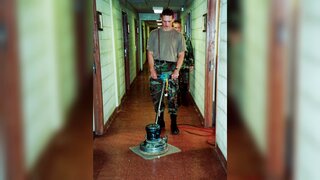Create a free profile to get unlimited access to exclusive videos, breaking news, sweepstakes, and more!
How Israel Keyes, ‘The Most Meticulous Serial Killer,’ Was Caught
Israel Keyes traveled all over America to hunt victims, but a crime in Alaska led to his downfall.

Israel Keyes stands alone in the nefarious realm of American serial killers. No, he’s not a household name like Ted Bundy, who he researched and admired, or Jeffrey Dahmer. Keyes has nonetheless been called “one of the most ambitious and terrifying serial killers in modern history.”
Before killing himself nearly a decade ago while in custody for the abduction and murder of 18-year-old Alaskan barista Samantha Koenig, 34-year-old Keyes confessed to slaying 11 people around the United States.
But authorities believe that Keyes low-balled his grisly exploits and that he snuffed out even more lives as he crisscrossed the country on treks he took regularly from his home base in Alaska. That’s where Keyes, who worked doing construction, lived a double life.
On one hand there was his mainstream, unremarkable world with his girlfriend and daughter. Like others, they were unaware that Keyes was, as Anchorage homicide detective Monique Doll in 2012 described it, “leading this kind of Dr. Jekyll and Mr. Hyde lifestyle.”
Who was Keyes? How was he caught? What drove him to murder?
A killer comes of age
Israel Keyes was born in Richmond, Utah in 1978, the second of 10 children. His upbringing was not a conventional one. His parents, nonconformists from California who eventually left the Mormon church, raised their brood in Colville, Washington in a cabin in the woods without electricity or running water.
A 12-year-old Keyes “took great interest” in a “militia-based white supremacist anti-Semitic church called the Ark,” Maureen Callahan wrote in “American Predator: The Hunt for the Most Meticulous Serial Killer of the 21st Century.” He was obsessed with guns and would steal them from neighbors. Setting fires and Satanism were other unsettling fascinations.
Keyes’ twisted preoccupations escalated into torturing and shooting animals, including a family cat. He tied the doomed creature to a tree before wounding it with a .22 revolver, according to Callahan. More sadistic acts followed: Keyes admitted to gutting a deer while it was alive, cbsnews.com reported.
In a shudder-inducing admission about what made him tick, Keyes revealed: “I would hunt anything with a heartbeat,” according to Callahan. By the time he was 18, Keyes had set his predatory sights on people.
A murderer’s "unwritten rule"
Keyes told federal agents in Alaska that he raped — but did not kill — his first victim in Oregon between 1996 and 1998, according to FBI archives. The girl was between 14 and 18 years old.
“Keyes was able to discreetly separate her” from her group of friends that were tubing before sexually assaulting her on the Deschutes River near Maupin, Oregon. He was living there at the time, reported the Alaska Native News. Keyes ultimately released the girl after the attack.
It is unknown if this victim reported the crime, but the crime established an “unwritten rule” for Keyes, who made his kills away from his home. He told investigators that he regularly traveled great distances and “liked to find his victims along hiking trails, at campgrounds, and in other remote areas,” according to the FBI report. Similarly, he would dispose of victims’ bodies far from murder scenes to add distance between him and the crimes.
Keyes chose victims in no particular pattern in order to avoid connection and detection. Victims encountered a “force of pure evil acting at random,” said Tristram Coffin, the U.S. attorney for Vermont.
Kill kits buried for future crimes
In addition to intentional randomness, Keyes relied on detailed planning that led to him being called “the most meticulous serial killer.”
After his arrest, Keyes told investigators that during his trips he would bury “murder kits” containing weapons and supplies to dispose of his victims' bodies in future crimes in the vicinity of where he planned to later attack. Stashes included duct tape, shovels, guns, rope, Drano, and lye.
“The caches provided further cover because Keyes didn’t have to risk boarding an airplane with a weapon or using credit cards that could later connect him to a crime in a particular area,” according to the FBI.
Keyes said he had up to 12 kill kits buried across the country. Officials believe more of his stashes are buried around the country and that they could contain evidence in other unsolved murders.
Military service followed by multiple murders
Keyes joined the U.S. Army in 1998. He was discharged in 2001 and settled in Washington State — it was then the killing began. Keyes confessed to murdering 11 people across the United States between 2001 and 2012, although only three of his victims have been identified.
An FBI timeline showed that Keyes took about three dozen trips between 2004 and 2012. His travels spanned the entire country, including Hawaii. There were also trips to Canada and Mexico listed.
Keyes, who is suspected of killing two teenage girls between 1996 and 1998, told authorities he committed his first murder in 2001. The identity and whereabouts of that victim are unknown. He also admitted to committing a double homicide between July of 2001 and 2005 in Washington State. Keyes also spoke of two additional murders in that time frame.
A killer’s home – and capture – in Alaska
Keyes moved to Anchorage, Alaska in 2007. He started a construction business, using handy skills he’d developed in his youth. Keyes would often leave Anchorage and his family behind, using work or visits to relatives as an excuse. Instead, he went on to murder people in Washington, Vermont, and several other states.
He said that in April 2009 he abducted a female victim from an East Coast and killed and disposed of her body at a location in upstate New York.
In June 2011, Keyes flew from Alaska to Chicago. He rented a car and drove to Essex, Vermont where he spent three days looking for his next victims. Keyes had stashed a kill kit in the area years earlier.
Keyes admitted to breaking into the home of Bill and Lorraine Currier in June 2011. He abducted them and drove them to an abandoned farmhouse, where he shot Bill, 49, and sexually assaulted Lorraine, 55, before strangling her.
Keyes told the FBI that he disposed of the weapon at the Blakes River Reservoir. The FBI recovered the murder weapon and a cache left by Keyes at a nearby location.
A killer’s rule is broken
Keyes admitted to killing Samantha Koenig, an 18-year-old barista, in 2012 in Alaska. He broke his own rule about never choosing a victim who lived in close proximity to him. The line between his mainstream and shadow lives blurred.
He had abducted her at gunpoint from the coffee booth where she worked before sexually assaulting and strangling her.
Keyes left Koenig’s body in his shed while he went on a preplanned vacation with his girlfriend and daughter. When he returned he plotted to get a ransom: He applied makeup to Koenig’s body and sewed her eyes open before snapping a picture of her. Then, Keyes dismembered her body and disposed of it in a lake.
He made an error though: He used Koenig’s credit card at an ATM, which tipped off authorities to the car he was driving and his whereabouts. On March 13, a state trooper noticed a vehicle matching a description of the one Keyes was driving in a Texas hotel parking lot.
Keyes was pulled over. A search of the car uncovered Koenig’s ID, her debit card, her cellphone, and a gun — along with a disguise worn by the individual in the ATM security photo.
Cat and mouse with authorities
Keyes agreed to be interviewed by investigators in the seven months after his arrest. He was selective and evasive about the information he revealed and kept hidden, though.
Investigators believe there may be seven more victims based on comments made by Keyes in interviews and drawings of skulls found in Keyes’ cell that he made using his own blood.
However, they weren't able to get any more answers from Keyes. Officials determined that Keyes cut his left wrist using a blade from a disposable shaving razor that had been embedded into a pencil and used some of the bedding material in his cell to strangle himself.
The question that looms is why Keyes killed. One widely floated theory is that the motive was sheer pleasure. In “American Predator,” Callahan considers that Keyes even endured elective surgeries to become a more effective killer.
“He provided some motivation, but I don’t think it's really [possible] to pigeonhole why he did this,” Tristram Coffin, U.S. Attorney in Vermont, said in December 2012. "He described to investigators that this was a volitional act of his … It was something that he could control and he liked to do it. Why someone likes to act like that, nobody knows.”
For more on Keyes’ story, watch Oxygen’s “Method of a Serial Killer.”
